Acceleration Techniques
May 2020 (2719 Words, 16 Minutes)
Building the Bounding Volume Hierarchy
I recursively build the BVH tree inside of the Mesh object, BVH nodes are defined as:
struct BVHNode {
BoundingBox bbox;
std::vector<Face> faces;
std::unique_ptr<BVHNode> left;
std::unique_ptr<BVHNode> right;
};The strategy is to sort a collection of faces by their centroid (alternating sorts on the x, y, and z axis as we recurse down), and then divide the sorted collection in half. One half is passed down to the current node’s right child, and the other half to the left. We then calculate the bounding box of the children nodes and recurse down to the left and the right. The recursion is controlled by two tunable parameters triangleThreshold - the maxumum number of triangles we want in a node, and maxDepth - the maximum number of times we can recurse down and create new nodes, this overrides triangleThreshold to prevent a runaway recursion scenario. These are are set on a per mesh basis in the scene description Hypothetically allowing us to tune each mesh for example. There are two functions controlling this recursive creation behavior:
BuildBVH(size_t triangleThreshold, size_t maxDepth)
RecursiveBuildBVH(size_t triangleThreshold, size_t maxDepth, size_t currentDepth, BVHNode* nodePtr)The first, has the added responsibility of calculating the entire mesh’s bounding box, it also sets up the initial depth counter, this can be found in mesh.cpp on line 169.
void Mesh::BuildBVH(size_t triangleThreshold, size_t maxDepth) {
std::sort(faces.begin(), faces.end(), CentroidX());
size_t faceDiv = faces.size() / 2;
headNode.bbox = BoundingBox(faces);
//distribute the faces among sub nodes
headNode.left = std::unique_ptr<BVHNode>(new BVHNode);
headNode.left->faces = std::vector<Face>(faces.begin(), faces.begin() + faceDiv);
headNode.left->bbox = BoundingBox(headNode.left->faces);
headNode.right = std::unique_ptr<BVHNode>(new BVHNode);
headNode.right->faces = std::vector<Face>(faces.begin() + faceDiv, faces.end());
headNode.right->bbox = BoundingBox(headNode.right->faces);
RecursiveBuildBVH(triangleThreshold, maxDepth, 1, headNode.left.get());
RecursiveBuildBVH(triangleThreshold, maxDepth, 1, headNode.right.get());
}
void Mesh::RecursiveBuildBVH(size_t triangleThreshold, size_t maxDepth, size_t currentDepth, BVHNode* nodePtr){
if (currentDepth > maxDepth || nodePtr->faces.size() < triangleThreshold) {
return;
}
size_t sortIndex = currentDepth % 3;
switch (sortIndex)
{
case 0:
std::sort(nodePtr->faces.begin(), nodePtr->faces.end(), CentroidX());
break;
case 1:
std::sort(nodePtr->faces.begin(), nodePtr->faces.end(), CentroidY());
break;
case 2:
std::sort(nodePtr->faces.begin(), nodePtr->faces.end(), CentroidZ());
break;
default:
std::cout << "Mesh - Recursive Build BVH - This should never happen" << std::endl;
break;
}
size_t faceDiv = nodePtr->faces.size() / 2;
nodePtr->left = std::unique_ptr<BVHNode>(new BVHNode);
nodePtr->left->faces = std::vector<Face>(nodePtr->faces.begin(), nodePtr->faces.begin() + faceDiv);
nodePtr->left->bbox = BoundingBox(nodePtr->left->faces);
nodePtr->right = std::unique_ptr<BVHNode>(new BVHNode);
nodePtr->right->faces = std::vector<Face>(nodePtr->faces.begin() + faceDiv, nodePtr->faces.end());
nodePtr->right->bbox = BoundingBox(nodePtr->right->faces);
RecursiveBuildBVH(triangleThreshold, maxDepth, currentDepth + 1, nodePtr->right.get());
RecursiveBuildBVH(triangleThreshold, maxDepth, currentDepth + 1, nodePtr->left.get());
}Intersecting the BVH
The intersection is structured similarly with a recursive tree traversal, checking the ray against smaller and smaller bounding boxes until a node with no children is reached, then we run a ray intersect against the faces in that node and return up the results of the intersection. This code is on line 225 of mesh.h
bool Mesh::CheckIntersectionBVHRec(const Ray& ray, float& distance, glm::vec3& normAtIntersection, Pixel& pix,
BVHNode * node) {
// sanity null check
if (node == nullptr) {
return false;
}
//does the ray intersect this node or its children?
if (!node->bbox.CheckIntersection(ray, distance)){
return false;
}
// if there are no child nodes, this is a leaf, run intersection against
// the faces
if (node->left == nullptr && node->right == nullptr) {
return IntersectCollectionOfFaces(ray, distance, normAtIntersection, pix, node->faces);
}
if (node->left == nullptr || node->right == nullptr) {
std::cout << "Mesh - CheckIntersectionBVHRec - This should never happen" << std::endl;
}
//if there are child nodes, recurse down the tree, "return" smallest distance
float leftDist = std::numeric_limits<float>::max();
float rightDist = std::numeric_limits<float>::max();
glm::vec3 leftNorm;
glm::vec3 rightNorm;
Pixel leftPix;
Pixel rightPix;
bool intersectLeft = CheckIntersectionBVHRec(ray, leftDist, leftNorm, leftPix, node->left.get());
bool intersectRight = CheckIntersectionBVHRec(ray, rightDist, rightNorm, rightPix, node->right.get());
// This is obnoxiously verbose, but when I tried to condense everything down into clever little blocks
// of code I ended up with false negatives, or inverted geometry where the farther pixel was reported
// over the nearer one. Ill trade elegance for readability and correctness any day.
if (intersectRight && intersectLeft) {
if (rightDist < leftDist) {
distance = rightDist;
normAtIntersection = rightNorm;
pix = rightPix;;
}
else {
distance = leftDist;
normAtIntersection = leftNorm;
pix = leftPix;
}
return true;
}
if (intersectRight ) {
distance = rightDist;
normAtIntersection = rightNorm;
pix = rightPix;;
return true;
}
if (intersectLeft ) {
distance = leftDist;
normAtIntersection = leftNorm;
pix = leftPix;
return true;
}
return false;
}Images and The Speedup From Optimization
Remember this scene from assignment 2?
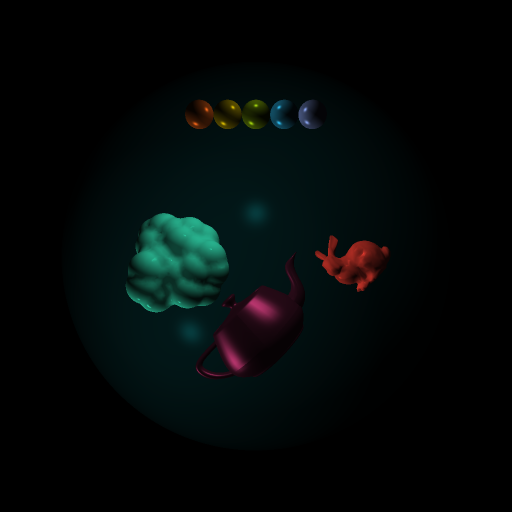
And recall its over 8 minute render time? Here is its log, just in case.
Screen - Setting up image as 512 by 512
Sphere - Set up sphere at: [0, 0, -20] with radius: 15
Mesh - Loaded mesh: assets/penny3.smf with 3675 verts and 7344 faces
Mesh - Loaded mesh: assets/teapot.smf with 3644 verts and 6320 faces
Mesh - Loaded mesh: assets/bunny-1000.smf with 502 verts and 1000 faces
Sphere - Set up sphere at: [-2, 5, 3] with radius: 0.5
Sphere - Set up sphere at: [-1, 5, 3] with radius: 0.5
Sphere - Set up sphere at: [0, 5, 3] with radius: 0.5
Sphere - Set up sphere at: [1, 5, 3] with radius: 0.5
Sphere - Set up sphere at: [2, 5, 3] with radius: 0.5
Raytracer - Performing inital setup with:
Camera at vec4(0.000000, 0.000000, 20.000000, 1.000000)
Camera Space - X: vec3(1.000000, -0.000000, 0.000000)
Camera Space - Y: vec3(0.000000, 1.000000, 0.000000)
Camera Space - Z: vec3(0.000000, 0.000000, -1.000000)
Dist to view plane 1
View angle (DEG) 56
View Plane center at: vec3(0.000000, 0.000000, 19.000000)
View Plane upper left at: vec3(-0.531709, 0.531709, 19.000000)
Raytracer - Supersampling enabled, computations will be done on an 1024 x 1024image
Raytracer - Starting raytrace of scene..........DONE
Raytracer - Full Screen color norm pass
Raytracer - Supersampling image down to 512 x 512
Raytracer - Tracing took 513715ms
Raytracer - image proccessing took 17ms
Raytracer - Total time: 513732ms
Screen - Writing 262144 pixels to 512 by 512 file: ss-misc-models-and-spheres.pngThat 513732m time is really unwieldy, especially as we add more steps that will be casting rays for shadows, reflection, and other features. After implementing bounding volumes (boxes) and a BVH optimization approach we now have the same image
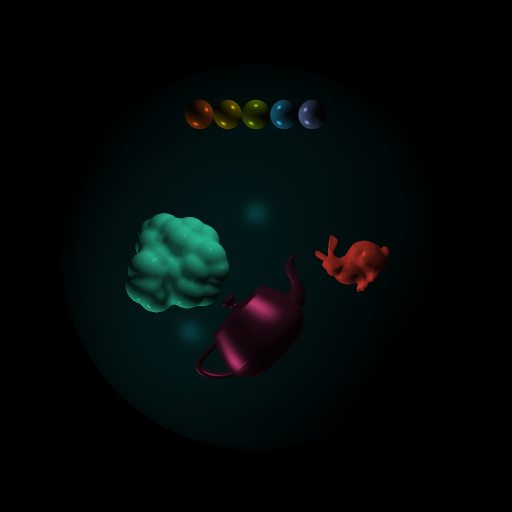
but with a much smaller render time! Its down to 394ms! (note that the log now also prints out the two opposite verts that define a mesh’s bounding box)
Screen - Setting up image as 512 by 512
Sphere - Set up sphere at: [0, 0, -20] with radius: 15
Mesh - Loaded mesh: assets/penny3.smf with 3675 verts and 7344 faces
bounded at min [-5.12625, -2.2605, -1.54025] max [-1.07975 1.7915 1.75375]
Mesh - Loaded mesh: assets/teapot.smf with 3644 verts and 6320 faces
bounded at min [-2.50771, -5.11259, -2] max [2.04652 0.176809 2]
Mesh - Loaded mesh: assets/bunny-1000.smf with 502 verts and 1000 faces
bounded at min [2.53791, -1.48794, -0.968468] max [5.5162 0.871868 0.968468]
Sphere - Set up sphere at: [-2, 5, 3] with radius: 0.5
Sphere - Set up sphere at: [-1, 5, 3] with radius: 0.5
Sphere - Set up sphere at: [0, 5, 3] with radius: 0.5
Sphere - Set up sphere at: [1, 5, 3] with radius: 0.5
Sphere - Set up sphere at: [2, 5, 3] with radius: 0.5
Raytracer - Performing inital setup with:
Camera at vec4(0.000000, 0.000000, 20.000000, 1.000000)
Camera Space - X: vec3(1.000000, -0.000000, 0.000000)
Camera Space - Y: vec3(0.000000, 1.000000, 0.000000)
Camera Space - Z: vec3(0.000000, 0.000000, -1.000000)
Dist to view plane 1
View angle (DEG) 56
View Plane center at: vec3(0.000000, 0.000000, 19.000000)
View Plane upper left at: vec3(-0.531709, 0.531709, 19.000000)
Raytracer - Supersampling enabled, computations will be done on an 1024 x 1024image
Raytracer - Starting raytrace of scene..........DONE
Raytracer - Full Screen color norm pass
Raytracer - Supersampling image down to 512 x 512
Raytracer - Tracing took 377ms
Raytracer - image proccessing took 17ms
Raytracer - Total time: 394ms
Screen - Writing 262144 pixels to 512 by 512 file: ss-misc-models-and-spheres.pngThat improves the run time by over 1000%, so thats a good thing in my book.
Lets look at a scene that had fewer triangles. While we don’t need to replicate the build logs for a second scene, we can discuss the other sphere and mesh scene from the previous homework
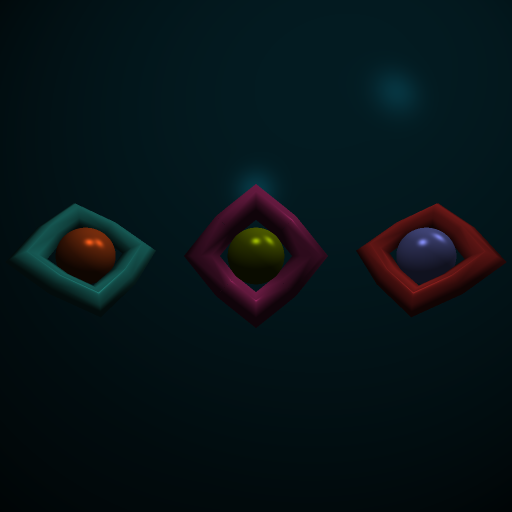
In HW2, before the optimizations, this scene took 13240ms. Now with the BVH in play we can cut that down to 479ms. Just to verify, heres the scene rendered with the optimizations
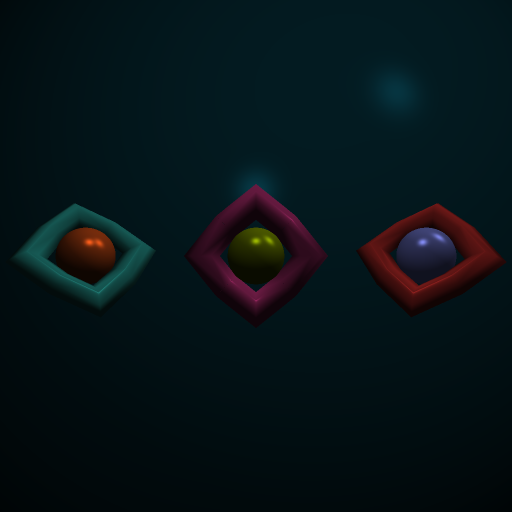
Lastly we can look at a single mesh scene. Since our BVH changes only impacts mesh objects we will see the biggest changes here. Two lights, one mesh of 50761 faces.
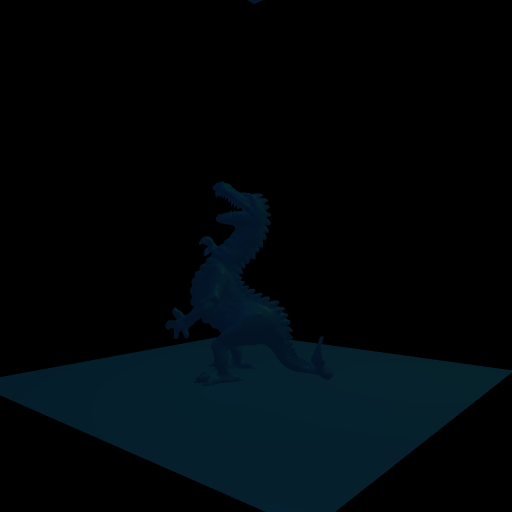
Heres the log:
Screen - Setting up image as 512 by 512
Mesh - Loaded mesh: assets/dragon.smf with 25418 verts and 50761 faces
Raytracer - Performing inital setup with:
Camera at vec4(0.000000, 0.000000, 20.000000, 1.000000)
Camera Space - X: vec3(1.000000, -0.000000, 0.000000)
Camera Space - Y: vec3(0.000000, 1.000000, 0.000000)
Camera Space - Z: vec3(0.000000, 0.000000, -1.000000)
Dist to view plane 1
View angle (DEG) 56
View Plane center at: vec3(0.000000, 0.000000, 19.000000)
View Plane upper left at: vec3(-0.531709, 0.531709, 19.000000)
Raytracer - Supersampling enabled, computations will be done on an 1024 x 1024image
Raytracer - Starting raytrace of scene..........DONE
Raytracer - Full Screen color norm pass
Raytracer - Supersampling image down to 512 x 512
Raytracer - Tracing took 26042355ms
Raytracer - image proccessing took 16ms
Raytracer - Total time: 26042371ms
Screen - Writing 262144 pixels to 512 by 512 file: ss-dragon.pngAnd now after the improvements we get the same scene
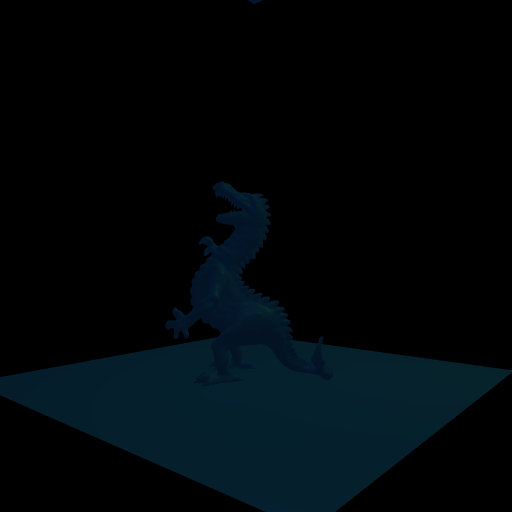
The log shows a significant speed up.
Screen - Setting up image as 512 by 512
Mesh - Loaded mesh: assets/dragon.smf with 25418 verts and 50761 faces
bounded at min [-11.2707, -5, -11.2707] max [11.2707 11 11.2707]
Raytracer - Performing inital setup with:
Camera at vec4(0.000000, 0.000000, 20.000000, 1.000000)
Camera Space - X: vec3(1.000000, -0.000000, 0.000000)
Camera Space - Y: vec3(0.000000, 1.000000, 0.000000)
Camera Space - Z: vec3(0.000000, 0.000000, -1.000000)
Dist to view plane 1
View angle (DEG) 56
View Plane center at: vec3(0.000000, 0.000000, 19.000000)
View Plane upper left at: vec3(-0.531709, 0.531709, 19.000000)
Raytracer - Supersampling enabled, computations will be done on an 1024 x 1024image
Raytracer - Starting raytrace of scene..........DONE
Raytracer - Full Screen color norm pass
Raytracer - Supersampling image down to 512 x 512
Raytracer - Tracing took 614ms
Raytracer - image proccessing took 16ms
Raytracer - Total time: 630ms
Screen - Writing 262144 pixels to 512 by 512 file: ss-dragon.pngIt is apparent that the speedup is directly related to the number of ray-triangle intersections we can avoid, the bounding boxes around progressively smaller clusters of faces enable us to fully skip entire chunks of the model.
Work in Progress Observations
The first thing I did was to wrap the polymesh objects in bounding boxes determined by the extreme x, y, and z values of the mesh’s individual verticies. This saw a massive improvement in render time, On the scene shown above, bounding boxes alone shifted total render time from 513,732ms to 28,889ms, thats an order of magnitude! This was on a scene that had several non-polymesh objects and near 15,000 total triangles. Since this bounding box change only impacts polymeshes and we still have to test one box per polymesh per pixel and n many spheres per pixel, the benefit of this speedup will scale with total scene complexity, ratio of spheres to triangles, and total number of triangles.
The next step was a clean up, I had tons of places where I passed around glm::vec3 pairs of origin and normRayVector, so I collapsed these into a Ray class. I did something similar with the Phong shading values, packing these into a Material class.
Once this was done I added the BVH node and the recursive methods to generate and traverse them as listed above. Once this was working I was able to observe the exceptional speed up, even beyond what bounding boxes by themselves could do.
Discussion of BVH vs Octree
for my own future reference: https://computergraphics.stackexchange.com/questions/7828/difference-between-bvh-and-octree-k-d-trees